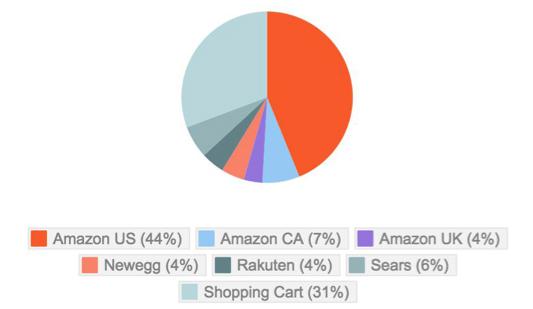Selling on Amazon.
We know that reading the phrase alone sends a chill down your spine as you know this storefront makes up most, if not all of your business’s revenue. Amazon is undoubtedly the top e-commerce marketplace, however it’s too easy to become addicted to selling on this platform.
Amazon is like a gateway drug. They make it easy to sell on their channel, and once you start it’s really hard to stop.
It gets to the point where Amazon sellers get so reliant on this one channel they become afraid of discovering what other avenues of selling exist off of Amazon.
What they don’t understand is that Amazon only makes up 44% of all e-commerce product searches. That’s 56% of customers that they could have access to, but unfortunately chose not to. We’re here to help further educate you and increase your e-commerce businesses profits by diversifying your revenue.
The following graph would be an on average sales diversity for a seller:

Four Reasons Why You Should Diversify Your Marketplace Revenue
- People Base Their Decisions by Comparing All of Their Options
As a consumer, you’re inclined to finding the best deal possible before clicking the ‘buy’ button. Most consumers do a simple Google search, and check their go-to marketplaces. One would almost always be Amazon, but what about their second choice? Places like eBay, Sears, Newegg and many more are valuable marketplace options.
More than likely, your product’s pricing is based on the competitiveness of Amazon. Because it’s based on the marketplace with the highest competition, your price may be lower on your other channels as well, which in turn, could have the customer make their purchase there.
- The Need to Be Everywhere
Tying into our previous reason, being everywhere is reaching every potential consumer. While most consumers check Amazon, not everyone of them shop on Amazon. Those who don’t have Amazon Prime are less inclined to buy from Amazon. Having your branded products on several marketplaces not only assures the customer of the validity of your brand, but provides your customers with options as your prices fluctuate across multiple channels.
When it comes to succeeding in the world of e-commerce we look at it like a game of Monopoly. In order to win at Monopoly you need to be everywhere on the board. Selling online is no different.
- When You Own Your Own Shopping Cart, You Own the Customer
If you own your own shopping cart, whether it’s on Magento, Shopify, BigCommerce or whichever platform, you gain customer insight. There’s a wealth of information to be gained from every purchasing customer. You could decipher purchasing habits, commonly paired items and more. With this information you could become a smarter vendor by efficiently optimizing your targeted marketing efforts to segment your customer base.
- Ultimately More Profit
And of course, the most exciting reason about being on multiple channels is simply, MORE MONEY. Increasing your cash funnel, only means more cash to be had. Why limit your products’ potential by staying on a single channel when you could market to several and make more money?
Managing Multiple Marketplaces

The task may seem entirely daunting. You must be thinking, “Hey, I would be ecstatic to make more money by being everywhere, but I just lack the time to manage more than a handful of marketplaces!”
Oh don’t you worry mysterious inquirer. That’s where Skubana steps in.
Skubana was built for sellers by sellers providing most of the necessary tools for post-checkout processes.
We highly emphasize the importance of using an inventory management software when working with multiple marketplaces. With inventory management software you could:
- Allocate Inventory to provide higher quantity of stock to your more profitable channels.
- Create false scarcity: Nothing sparks a fire in your customer’s’ buying decisions than a near out-of-stock deal. Allocate your inventory to show just a handful of inventory left and watch it sell out quick. Then you could choose when to refill that inventory.
- Establish reorder min. levels: Don’t worry about having to check your stock levels every hour. You can establish min levels so that when your stock reached this minimum your software can automatically generate a purchase order, ready for your approval to restock before you run out.
- Never Oversell Again: This is the #1 killer, especially on Amazon when you have to hurt your seller health by cancelling customers’ orders. As soon as the quantity hits 0, or if you manually set the inventory to 0, all channels get zeroed out and you’re safe from overselling.
And Finally, Cross-Channel Analytics

The best way to get that final edge over your competition is to have the right analytics in place to understand how optimizing your channels can push your profitability even more. There are many pieces of analytical software that can support your business, but the idea isn’t to just record data, but implement it so you can make smarter decisions to increase your sales.
The right multi-channel analytics software should provide you with the following information:
- Listing Profitability: Understand which listings of your SKUs are most profitable. This provides insight into what marketplace performs best for which product.
- SKU Profitability: Stacking your SKUs against each other, understand which are the most profitable and why. This insight provides you the opportunity to focus on optimizing your weaker SKUs.
- Y-O-Y / M-O-M Growth: Compare your SKUs’ performance year over year across all channels to identify the unique peak seasons per channel and per SKU for better preparation.
- Product Performance: Performance pertains to the frequency of purchases, and shelf life. This insight identifies your products that are costing you money by taking up space in your warehouses without moving.
- Customer Lifetime Value: Identify how many repeat buyers and for how much on each sales channel. This insight allows you to understand how to market toward these customers by seeing into what products are bundled during purchase, and the frequency of their purchases.
- And many more that we have not mentioned but the above are some of the absolute necessary to fully comprehend what it takes to escalate your business when running multiple marketplaces.
Ready To Go Multi-Channel
Don’t worry if you can’t get on every marketplace right away. Start with one marketplace and expand from there. Build a storefront too!
Overall, going to multiple marketplaces is a win-win: your e-commerce will gain more exposure, and your customers will gain access to the services you provide.
Keep in mind to utilize the right software for when you make the multiple marketplace transition.And as always,
Work Smart. Sell More.
This guest post was contributed by the Skubana team. Skubana is an all-in-one ERP system that seamlessly integrates with your online marketplaces, 3PLs, warehouses, providing a state-of-the-art profitability and multi-channel inventory management experience. Skubana compiles all of your marketplaces on a single page to intuitively control and understand your entire business. Try Skubana Free for 14 days. Contact info@skubana.com with any questions!
Disclaimer: The information and views presented in this blog post are the opinions of the guest author, and not necessarily those of 888 Lots.







